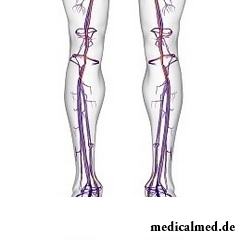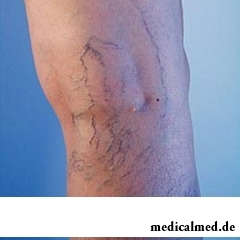





Veins of the lower extremities
The venous system  of the lower extremities of the person is presented by three systems: system of perforantny veins, superficial and deep systems.
of the lower extremities of the person is presented by three systems: system of perforantny veins, superficial and deep systems.
Perforantny veins
The main function of perforantny veins is connection of superficial and deep veins of the lower extremities. They received the name because they perforate (penetrate) anatomic partitions (a fascia and a muscle).
Most of them are equipped with the valves located nadfastsialno via which blood gets from superficial veins to deep. About a half of kommunikantny veins of foot of valves has no therefore blood from foot flows as from deep veins in superficial, and on the contrary. Everything depends on physiological conditions of outflow and a functional load.
Superficial veins of the lower extremities
The superficial venous system originates in the lower extremities from veniplexes of fingers of foot which create venous network of a back part of foot and a skin back arch of foot. From it the lateral and medial regional veins passing respectively into small and big saphenas begin. The bottom venous network connects to a back venous arch of foot, to an instep and deep veins of fingers.
The big saphena is the longest vein in an organism which contains 5-10 pairs of valves. Its diameter is equal in a normality to 3-5 mm. The big vein ahead of a medial anklebone of foot begins and rises to an inguinal fold where connects to a femoral vein. Sometimes the big vein on a shin and a hip can be presented by several trunks.
The small saphena originates in a back part of a lateral anklebone and rises to a subnodal vein. Sometimes the small vein rises above a popliteal space and connects to a femoral, deep vein of a hip or a big saphena. Therefore before carrying out surgical intervention the doctor has to know the exact place of a confluence of a small vein in deep to make an aim section directly over an anastomosis.
The femoral and knee vein is continuous priustyevy inflow of a small vein, and it falls into a big saphena. Also a large number of hypodermic and skin veins falls into a small vein, it is preferential in the lower third of a shin.
Deep veins of the lower extremities
On deep veins flows more than 90% of blood. Deep veins of the lower extremities in a back part of foot begin with plusnevy veins from where blood flows in tibial front veins. Back and front tibial veins merge at the level of a third of a shin, forming a subnodal vein which rises above and gets to the femoral and subnodal canal which is called already femoral vein. Above an inguinal fold the femoral vein connects to an outside ileal vein and is directed to heart.
Diseases of veins of the lower extremities
Treat the most widespread diseases of veins of the lower extremities:
- Varicosity;
- Thrombophlebitis of superficial veins;
- Vein thrombosis of the lower extremities.
Varicosity  is called the morbid condition of superficial vessels of system of small or big saphenas caused by valve insufficiency or an ectasia of veins. As a rule, the disease develops after twenty years, is preferential at women. It is considered that to a varicosity there is a genetic predisposition.
is called the morbid condition of superficial vessels of system of small or big saphenas caused by valve insufficiency or an ectasia of veins. As a rule, the disease develops after twenty years, is preferential at women. It is considered that to a varicosity there is a genetic predisposition.
The varicosity can be acquired (the ascending stage) or hereditary (the descending stage). Besides, distinguish primary and secondary varicosity. In the first case function of deep venous vessels is not broken, in the second case the disease is characterized by occlusion of deep veins or insufficiency of valves.
On clinical signs allocate three stages of a varicosity:
- Compensation stage. Expanded veins gyrose varicose without any other additional symptoms are standing visible. At this stage of a disease patients, as a rule, do not see a doctor.
- Subcompensation stage. Except a varicosity patients complain of passing hypostases in anklebones and feet, pastosity, feeling of a raspiraniye in shin muscles, bystry fatigue, spasms in gastrocnemius muscles (generally at night).
- Decompensation stage. In addition to above-mentioned symptoms at patients ekzemopodobny dermatitis and a skin itch are observed. At the started form of a varicosity there can be trophic ulcers and the strong xanthopathy resulting from small dot hemorrhages and deposits of hemosiderin.
Thrombophlebitis of superficial veins is a complication of a varicose vein disease of the lower extremities. The etiology of this disease is not studied sufficiently. Phlebitis can independently develop and lead to venous thrombosis, or the disease results from an infection and joins primary thrombosis of superficial veins.
The ascending thrombophlebitis of a big saphena is especially dangerous, so there is a threat of hit of the floating part of blood clot in an outside ileal vein or a deep vein of a hip that can cause a thromboembolism in vessels of a pulmonary artery.
The deep vein thrombosis is quite dangerous disease and poses threat for the patient's life. Thrombosis of the main veins of a hip and a basin often originates in deep veins of the lower extremities.
Allocate the following reasons of development of a vein thrombosis of the lower extremities:
- Bacterial infection;
- Excessive exercise stress or injury;
- Long bed rest (for example, at neurologic, therapeutic or surgical diseases);
- Reception of contraceptive tablets;
- Puerperal period;
- IDCS;
- Oncological diseases, in particular carcinoma of the stomach, lungs and pancreas.
The deep vein thrombosis is followed by hypostasis of a shin or all leg, patients feel constant weight in legs. Skin at a disease becomes glossy, through it the drawing of saphenas accurately appears. Also distribution of pain on the internal surface of a hip, shin, foot, and also shin pain is characteristic at a foot dorsiflexion. And, clinical symptoms of a deep vein thrombosis of the lower extremities are observed only in 50% of cases, in other 50% can not cause any visible symptoms.
In our intestines are born, millions of bacteria live and die. They can be seen only at strong increase, but if they gathered, then would be located in a usual coffee cup.

All like to sing. Small children with pleasure are engaged in a vocal, not especially thinking of hit in a melody. Adults most often...
Section: Articles about health
Vitamin complexes belong to the most popular drugs, probably, in our country there is no person who was not hearing about advantage of vitamins and never their accepting. The more vitamins, the better, we consider and as it appeared, cruelly we are mistaken. So l...
Section: Articles about health
The nature does not stand stagnation and monotony. It is known that tissues of a human body atrophy if do not receive necessary loadings. It fully belongs also to a cerebral cortex: when it is not given full-time job, it begins to function worse. As a result memory decreases, the person becomes less bright, acquires information more slowly, hardly switches from one thought to another. There are problems at work, difficulties with communication and career development. These it is unpleasant...
Section: Articles about health
Each person has easy indispositions which he transfers "standing", trying not to ask for medical care. Argu...
Section: Articles about health
One of the major chemical processes happening in a human body are oxidation reactions. They go with participation of fats and carbohydrates which we receive from food, and the oxygen getting to us from air. A main goal of such reactions is it is received...
Section: Articles about health
Season of activity of viral infections in the heat. Everyone can get sick, but probability of this unpleasant event it is possible and it is necessary to minimize. There is a number of rules, following to which will help or to avoid absolutely infection with flu or a SARS, or to have an illness benign and without essential complications. About ways of prevention of seasonal infections the speech in this article will also go....
Section: Articles about health
Each woman has preferences in the field of use of those goods which help us to look good, feel се...
Section: Articles about health
Almost each of us during life faced dissatisfaction with own body. At such moments, as a rule, we begin to shame ourselves, urgently we go on the most rigid diet promising minus of 10 kg in a week, or we exhaust ourselves in the gym to полусм...
Section: Articles about health
Very often as a source of the infection which caused a disease serves our house - the place which a priori has to be safe. However disease-producing bacteria can perfectly feel not only in insanitary conditions, but also in our apartment if not to carry out due care of favourite places of their dwelling. What they − sources of their reproduction? Let's consider 10 most widespread places in our house, the most dangerous from the point of view of infection with microorganisms....
Section: Articles about health
Life of the modern child is extremely active and difficult. Information strain which is experienced by the school student and did not dream the pupil...
Section: Articles about health
The medicine promptly develops, and the fact that else quite recently it seemed by miracle can now. We are not surprised any more to the fact that people with artificial joints and extremities can play sports, organ transplantation became a routine, and the latest cancer medicine п...
Section: Articles about health
It is impossible to imagine human life in which there would be no plants. Practically in each apartment and any production room there are window plants, millions of people with pleasure are engaged in gardening and truck farming, many citizens spend free time on seasonal dachas. However we very seldom pay attention to those properties of our green pets who can make the neighbourhood with them unpleasant and even unsafe....
Section: Articles about health
Transfusion of donor blood has almost century history. In spite of the fact that this procedure is quite usual for many people, itself п...
Section: Articles about health
Doctors claim that the people not so familiar with a dorsodynia occur among adult Russians very seldom. At the same time the vast majority of the patients who are periodically testing this indisposition do not hurry to ask for medical care at all. With one St...
Section: Articles about health
The technique of acupuncture (acupuncture) is used in the medical purposes more than three and a half millennia. It is eurysynusic and recognized as official medicine in the majority of the developed countries of the world. Influence by fine needles on so-called points of acupuncture contributes to normalization of a metabolism and hormonal background, activates protective forces of an organism, has anesthetic and antiinflammatory effect, stabilizes a condition of mentality....
Section: Articles about health
No, probably, the person who would not have cold. Cold, cough, a headache – these symptoms are known to everyone. Peak to Prost...
Section: Articles about health
For the help to doctors in the choice of optimal solutions for treatment of various diseases the Cochrane scientific organization (Cochrane) conducts joint researches with representatives of scientific community around the world. The analysis of a series became carried out by one of the last methanolyses...
Section: Articles about health
The brain of the person is studied not one hundred years, but the quantity of the riddles connected with this body increases rather, than decreases. Perhaps, numerous delusions concerning a structure and functioning of a brain are explained by it, many of which arose long ago, but continue to exist and today. Such we are ready to acquaint readers with the most widespread myths....
Section: Articles about health
Quite large number of people adheres to the principles of vegetarian food. But how to be if in a family of vegetarians is д...
Section: Articles about health
For the person who daily since morning gathers for work it is very important to wake up vigorous and ready by day of work. Actually, each of us experiences difficulties with this, at first sight, simple business from time to time. On a condition of an organism after ночн...
Section: Articles about health
The number of long-livers is very small. One person from 5 thousand lives up to age of 90 years, and the centenary boundary steps over only one of 20 thousand. However, doctors claim that each of us is quite able to affect own destiny. At the same time it is not so much about living as long as possible, how many about an opportunity to keep physical and intellectual activity and to avoid decrepitude. We will also talk about the ways helping to achieve this result today....
Section: Articles about health
According to data of World Health Organization, the cataract is diagnosed almost for 7% of the population of Earth. Statistics we get sick...
Section: Articles about health
Reactive pancreatitis - the disease which is characterized by inflammatory process in a pancreas which arises most often because of excess activity of digestive enzymes. It − the emergency state which treatment has to take place in хирургич...
Section: Articles about health
Life of the modern woman is very difficult. Opportunities to realize itself are wide: it not only education and career, but also the most various hobbies from sport before needlework. It is not less important to build private life, paying an attention maximum to children, the husband, parents, friends. For all these affairs there is catastrophically not enough time therefore each of us tries to cut down as far as possible its expenses on necessary, but not the most fascinating housework. With it we are successfully helped by means...
Section: Articles about health
The popular expression "run from a heart attack" became the motto of the people supporting active lifestyle. Moreover, run became peculiar...
Section: Articles about health
Each of us faces from time to time that other people need the immediate help. We react to it differently: one at once call doctors and police, others rush to victims and try to save them independently. Some at all...
Section: Articles about health
The varicosity has familiarly many, statistically, this disease more than a half of all adult population. As a rule, the varicosis affects preferential superficial vessels, and is shown by characteristic cosmetic defects. The deep vein thrombosis as this illness at the initial stages can imperceptibly proceed is represented much more dangerous, and in the started cases threatens with serious danger – thrombosis. This state, when the blood clot formed...
Section: Articles about health
